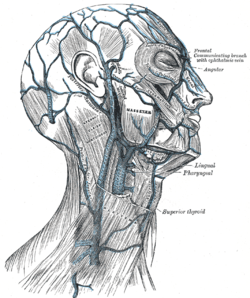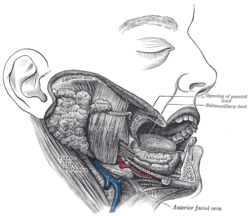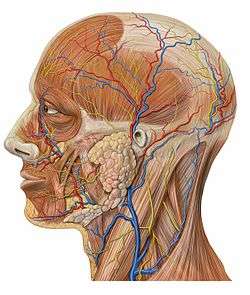Retromandibular vein
The retromandibular vein (temporomaxillary vein, posterior facial vein), formed by the union of the superficial temporal and maxillary veins, descends in the substance of the parotid gland, superficial to the external carotid artery but beneath the facial nerve, between the ramus of the mandible and the sternocleidomastoideus muscle.
| Posterior facial vein | |
|---|---|
 Veins of the head and neck (retromandibular vein visible at center). | |
 Dissection, showing salivary glands of right side (retromandibular vein visible at bottom center). | |
| Details | |
| Source | Superficial temporal vein, maxillary veins |
| Drains to | External jugular vein |
| Artery | Facial artery |
| Identifiers | |
| Latin | Vena retromandibularis, vena facialis posterior |
| TA | A12.3.05.031 |
| FMA | 50928 |
| Anatomical terminology | |
It divides into two branches:
- an anterior, which passes forward and joins anterior facial vein, to form the common facial vein, which then drains into the internal jugular vein.
- a posterior, which is joined by the posterior auricular vein and becomes the external jugular vein.
Parrot's sign is a sensation of pain when pressure is applied to the retromandibular region.
Additional images
 Lateral head anatomy detail
Lateral head anatomy detail
References
This article incorporates text in the public domain from page 646 of the 20th edition of Gray's Anatomy (1918)
External links
- Anatomy photo:27:13-0103 at the SUNY Downstate Medical Center - "Infratemporal fossa: The Pterygoid plexus of Veins"
- lesson4 at The Anatomy Lesson by Wesley Norman (Georgetown University) (parotid2)
- Tufts.edu
This article is issued from
Wikipedia.
The text is licensed under Creative
Commons - Attribution - Sharealike.
Additional terms may apply for the media files.